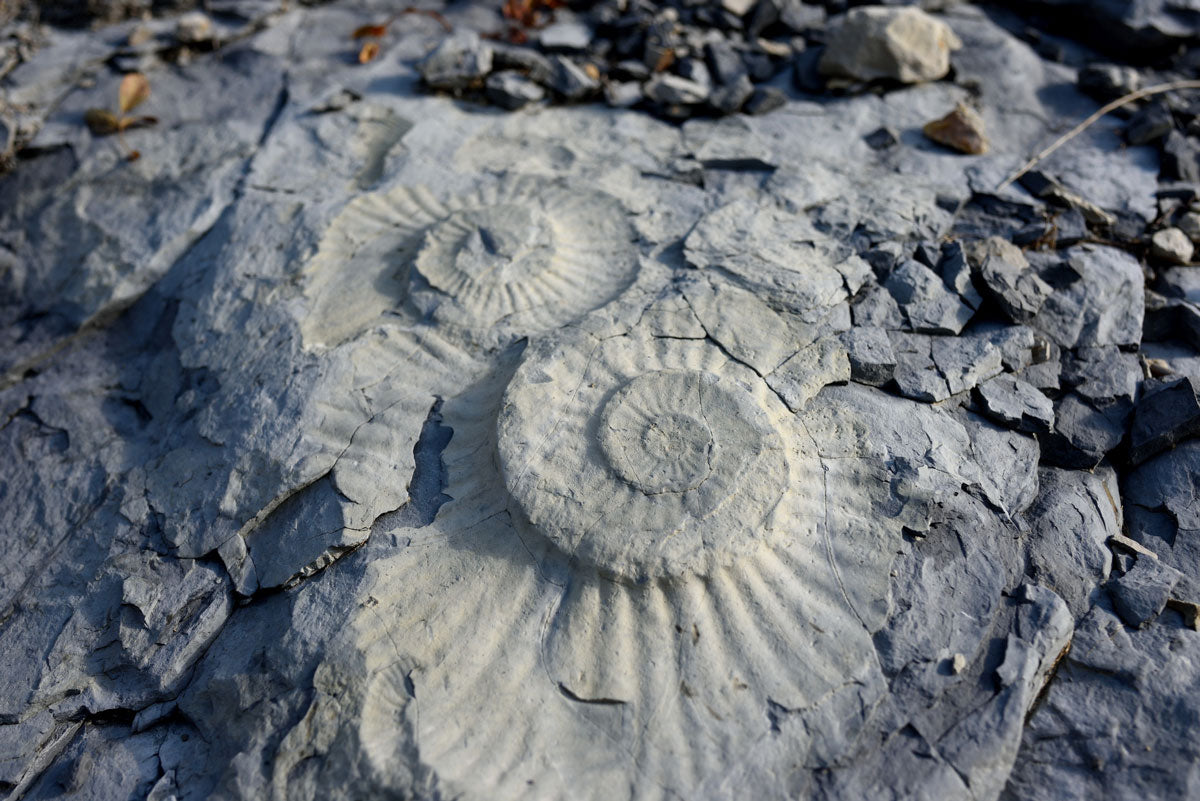
How Fossils Are Made & What They Teach Us
Just like snowflakes, each fossil is unique in its own way. So, how exactly are fossils made, and why is each type of fossil different? We asked ourselves the same thing, and we were blown away by how fossils are made and the amount of information they provide to scientists about a world that once existed.
How Are Fossils Formed?
Fossils are most commonly formed when a living organism dies and is quickly buried by sand, mud, or volcanic ash. The soft tissue decomposes, leaving the shell or bones behind. After being buried for an extended period of time, the layers harden into the rock.
What is Fossilization?
A fossil is any preserved remains, traces, or impressions of a once-living thing. Fossilization is the process of an animal or plant becoming preserved in a hard, petrified form. Fossilization is a crucial piece of scientists learning about life before humans.
5 Ways Fossils are Formed:
- Permineralization
- Impression
- Amber
- Trace fossils
- Soft tissues
Fossils Formed by Permineralization
Permineralization occurs when dissolved minerals fill up space inside the cells of plants and animals. The minerals then crystalize in the spaces and eventually form rocks. This is the most common type of fossilization. This process turns plants and animals into fossils that may not have been fossilized otherwise.
Fossils Formed by Impression

Impression fossils are formed when an organism’s original bone is removed after it has been buried. If the remains were fully decomposed, an impression is left in the empty space. This is known as a cast, and minerals fill the empty space forming a 3D shape of the organism.
Fossils Formed by Amber
Amber can preserve organisms trapped in tree resin (“Jurassic Park,” anyone?). For example, several fossils that are encased in amber most likely flew or crawled into fresh sap and got stuck. As the sap continued to cover the trapped animal, the resin eventually hardened and formed the fossil. Amber has been known to preserve fossils up to 100 million years old.
Trace Fossils
Trace fossils are formed when an organism makes a mark in sand or mud that then dries and hardens. This type of fossilization provides scientists with evidence of life in the past and the behavioral attributes of these organisms.
There are 4 types of trace fossils:
- Tracks and trails (footprints)
- Burrows and bores (wormholes)
- Gastroliths (stomach stones)
- Coprolites (fossilized feces)
Fossils Formed by Soft Tissues
Soft-tissue fossils are extremely rare because skin, eyes, and brains don’t preserve like skeletons. However, in 2005, a scientist found soft tissue in a 75-million-year-old dinosaur leg bone. This type of fossil is highly sought after as it gives us a better look into species we still know so little about.
How are Fossils Used by Scientists?
Scientists study different types of fossils to learn how long life has existed on Earth and how many different plants and animals existed and interacted with each other. This also allows scientists to gain valuable information on how species that exist in the world today survived throughout the past. Being able to connect species today to the species of the past allows us to learn about life on Earth as a whole and how it has evolved or relatively stayed the same over the years.
Different Types of Fossils
Whaler’s Locker has several fossils, each one-of-a-kind and stunning, that anyone would want to add to their collection.
Our 5 most popular types of fossils are:
- Sand Dollar Fossil
- Phylloceras Ammonite Fossil
- Phacops Trilobite Fossil
- Double Moroccan Mosasaur Fossil Tooth
- Polished Coral
Sand Dollar Fossil
One of the most popular types of fossils is a sand dollar. Sand dollar fossils are formed when the remains of the organism are found. Sand dollars are around 201 million years old and were alive during the Jurassic period and can be found just about anywhere.
Sand dollars tend to live in large colonies and burrow into muddy or sandy seafloors - the perfect place for fossils to form. So, if you find one sand dollar, hundreds should be close by. Sand dollars have been used for decorations, gifts, and even jewelry throughout history.
Phylloceras Ammonite Fossil
The Phylloceras fossil is one of our most unique fossils. Ammonites are more likely to go through the fossilization process because of their hard shells. Their shells have been known to survive tens of millions of years with virtually no damage. Ammonite fossils are also known as index fossils. Index fossils are used to identify dates and other correlating factors during a period of time.
Phacops Trilobite Fossil
Trilobite fossils are most commonly found in the mountains of western Canada, Eastern Europe, the deserts of northern Africa, and southern China. However, trilobite fossils are so common that they can be discovered on almost every continent on Earth. Phacops is related to the phacopidae family that lived primarily in North and South America, China, Northwestern Africa, and Europe.
They were most commonly found rolled up, even in their fossilized state. This was a defense mechanism that smaller trilobites used to protect themselves. Recognized by their distinctive three-segmented form, trilobites were distinctively marine animals and existed 542 million years ago.
Double Moroccan Mosasaur Fossil Tooth in Matrix
A matrix is a rock that forms around the fossilized organism during the fossilization process. While you could potentially remove the matrix, you risk damaging the fossil itself, so fossils found in a matrix are often left as is.
Shark teeth are the most common fossils found in matrix, most likely due to their size and shape. Since sharks shed old teeth all the time, when the teeth hit the seafloor, they are easily buried.
Polished Fossil Coral
Corals are marine animals whose skeletons are fossilized. The fossil coral forms when the natural gemstone is slowly replaced with agate. The oldest fossilized coral is over 500 million years old! While the earliest forms of the species are different from what we see today, any type of fossil coral is popular and collected by fossil lovers all over the world.
The fossilization process is unique and has continued to provide us with endless information about the world that existed before us. So, if you are looking to build your fossil collection and own some one-of-a-kind pieces, we have you covered. At Whaler’s Locker, we could talk about fossils all day long!



